25.08.2005
M.Notkin. Drinking May tea
There was a famous advertisement slogan "May tee is the favorite one". If it is true, then with high probability we can suppose that the games of May are the favorite ones. So to speak, it is a syllogizmus. Why do you pester me with your red wavy lines, I know how to write beautiful words better. I am sorry, I am talking to my Wordie. Oh, he has not recognized even himself! And what do you propose instead of it? Wordier, wordy, wordiest... Well, it is so interesting to communicate with an ordered mind. Perhaps, I do not really understand something. Let us check it up – if the readers dislike the games of this survey, then my logic is poor, and therefore, everything else is disputed, and I will have to take courses that raise the level of general culture. Please notice, I give odds to my imaginary opponent: as it was already said while the results were summed up, the best encounters had already been annotated by kind and prompt people. The best of my favorite games took only the 7th place, the others even did not get into the top ten, and nevertheless, I hope you will like them.
It is very important to have a right start. No adagio, lyric, semi-tones. The captioning data are still appearing on the screen; the latecomer viewers thread on their places, and fire and scuffle are already on the screen.
N.NINOV – I.CHEPARINOV
Bulgarian championship
The selection of this game as the opening of the whole set is right from the ideological point of view. May was the month of Topalov, and his young compatriot made a lot for the victory of Veselin in Sofia.
Sergey Zagrebelny said the following: "This western in style of the 19th century masters could have taken a higher place, but it was simply unlucky. The competition was severe this time. And the great ones pressed not only by their authority. Young Cheparinov can complain only about the schedule, because Bulgarians could have postponed the country championship in view of the supertournament. It turned out that it was not time for Cheparinov to play before Topalov..."
1.e4 e5 2.¤f3 ¤c6 3.Ґc4 ¤f6 4.¤g5 d5 5.exd5 ¤d4 6.c3 b5 7.Ґf1 ¤xd5 8.cxd4 Јxg5. Let us not sink into the theoretical deeps, because we can easily stick in it for a long time despite the fact that this variation is considered to be minor to 5...¤a5.
9.¤c3. Deviating from the main theoretical path 9.Ґxb5+ ўd8 10.Јf3 Ґb7 11.0-0 with complicated play.
9...exd4 10.Ґxb5+ ўd8!? The encounter of two great inventors van der Wiel - Timman, Amsterdam 1980 went: 10...Ґd7 11.Ґxd7+ ўxd7 12.0-0! ¤f4 (in case of 12...dxc3 13.dxc3 White regains the piece due to the pin along the d-file)13.g3 ¤h3+! 14.ўg2 ¤f4+ 15.ўh1?! (15.ўg1 leads to a draw, but it is a shame to take it now – the game has just started) 15...dxc3! 16.Јa4+ (now 16.dxc3+? fails to 16...Јd5+ check, and Black remains with an extra pawn) 16...c6 17.gxf4 (in case of 17.Јxf4 Јxf4 18.gxf4 Timman could have made an amusing move 18...c2! with a better endgame for Black) 17...Јd5+ 18.ўg1 cxb2 19.Ґxb2 Ґc5, and Black can be satisfied with the results of the opening.
11.Ґc6. Bad is 11.¤xd5? Јxg2 12.¦f1 Јxd5 with a huge advantage for Black.
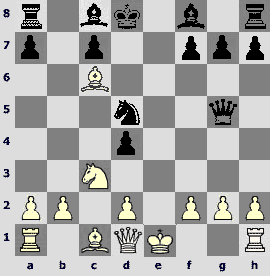
11...¤f4! Like Timman 25 years ago, Cheparinov has quickly made sure that 11...dxc3 12.dxc3 was bad. I do not presume that Ivan knew the game Toma – A.Vaida that was played in 1999 in Romania. The only game in the base on the subject saw 11...Ґa6?! 12.¤xd5 Јxg2? (12...Јe5+ 13.¤e3 ¦b8 14.Јg4 Ґc8 15.Јe4±) 13.¤e7! («equal» 13.¤b4? is impossible in view of 13...Ґxb4!) 13...Јg5 14.Јf3! Ґxe7 (restoring the material equality by means of 14...Јxe7+ 15.ўd1 ¦b8, Black loses straight away shortly after 16.¦e1) 15.Ґxa8 Ґd6 16.Ґc6, and White won soon. Be it as it may, Cheparinov has played much stronger.
12.Ґxa8. If you raise your glass, you have to drink it dry. In case of 12.0-0 ¦b8 13.¤e2 d3 White could hardly derive pleasure from the play. Although actually it would be safer.
12...¤xg2+ 13.ўf1. A "fianchetto" 13.Ґxg2? leads to a defeat after 13...Јxg2 14.¦f1 Ґc5 or even keen 14...d3! followed by Ґc5 and ¦e8.
13...Ґh3 14.d3!? Actions of White correspond with his highly romantic mood, as he prefers indirect defense of the queen to escape from the danger (¤e3+). 14.Јf3 does not work in view of 14...¤f4+ 15.ўe1 Ґg2! 16.Јg3 Јxg3 17.fxg3 Ґxa8, and Black receives a material advantage in the ending.
However, 14.Јb3!? deserved attention. The following variation leads to a sharp endgame 14...¤f4+ 15.ўe1 Јe5+ 16.ўd1 ¤d3 17.Јb8+ ўd7 18.Јb5+ Јxb5 19.¤xb5 ¤xf2+ 20.ўe1 ¤xh1 21.Ґxh1 d3!, and in case of 14...Јg4!? (threatening 15...¤f4+ 16.ўe1 ¤d3#!) only the fact that White has a perpetual check is clear – 15.Јb8+ ўd7 16.Јb5+ ўd8, and it is impossible to say what can happen, if you do not let the eternity push you around.
14...¤f4+. In case of14...¤e3+? 15.ўe1 the knight is just an obstacle to the attack.
15.ўe1 dxc3 16.bxc3 Ґc5.

17.d4? A decisive mistake, after which the position of White becomes lost. Correct would be 17.Јf3 ¦e8+ 18.Ґe4 Јg2! 19.Јxf4 Јxh1+ 20.ўd2 Јf1 21.Јg5+ Ґe7 22.Јe3 with extremely uncertain position.
17...¦e8+ 18.ўd2. A player usually does not plan such move. Most likely Ninov has counted on 18.Ґe3, but at closer examination he finds 18...¦xe3+! with mate – 19.fxe3 Јh4+ 20.ўd2 Јf2+ 21.ўc1 Ґa3+ 22.ўb1 Јb2#.
18...¤d5+. "Fritz" immediately shows that after 18...Јf5! Black wins on the spot – 19.Ґb2 Јd3+ 20.ўc1 ¤e2+ or 19.Јf3 Ґg2! If we judge according to the given numerical estimate, an opened check is almost 2 times weaker. However, it is by no means a consolation for White.
19.f4. After 19.ўc2 Јg6+ 20.ўb2 Јb6+ 21.Јb3 ¦e2+ 22.ўb1 Ґf5# or 20.ўd2 ¤b4! white king is mated.
19...Јg2+ 20.ўd3 Јe4+?! Again missing a more subtle move 20...Јg6+! which enables the black queen to fly over to another flank – 21.ўc4 (21.ўd2 ¦e3) 21...Јa6+, with nice mating finals in all cases 22.ўb3 Јb5+ 23.ўc2 Ґf5+, or 22.ўxd5 Ґf8! (threatening 23...Јb5# or 23...Ґg2+, there is no defense), or 22.ўxc5 Јa5+ 23.ўc4 Јxc3+! 24.ўxd5 (24.ўb5 Јb4+ 25.ўc6 ¤e7#) 24...Ґg2+.
21.ўc4 ¤b6+ 22.ўxc5. This is right! Nothing good is waiting for the king at home anyway – 22.ўb3 Јe6+ 23.ўb2 ¤c4+ or 23.d5 Јe4 °.

I understand that having sold myself into the bondage of the calculating machine, I am due to say the most shameful thing: 22...Јxa8 "and wins" is objectively the best move here. I realize that after these words I will be kept out from the "Regence" café for a long time. However, Ivan Cheparinov will be a desirable guest there.
22...Јe7+ 23.ўb5 Ґd7+ 24.ўa6! I have to thank Nikolai Ninov for the co-authorship. After 24.Ґc6 Ґxc6+ 25.ўxc6 Јd7+ the entertainment quickly finishes though not without elegance: Black mates using quiet moves – 26.ўc5 (26.ўb7 ¤c4) 26...a6! 27.ўb4 (27.a4 Јd6#) 27...Јb5+ 28.ўa3 ¤c4#.
24...Јd6 25.Јb3! Also unsuccessful is 25.¦b1 ¤xa8+ 26.ўa5 (26.ўxa7 ¤b6) 26...Јd5+ 27.ўb4 ¤b6. I think this game could have gathered a few (or even much) more judges' voices if it had ended in the following way: 25.ўxa7 ¤c8+ 26.ўb8 Јb6+ 27.Ґb7 Јa7#
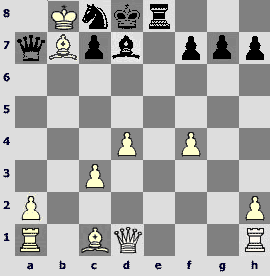
However, as it was said by Jerome K Jerome, "George is very dense at seeing a joke sometimes." Let us be equitable: White could hope here, though quite a little, for a successful outcome of the king's voyage.
25...¤xa8+ 26.ўa5 Ґc8. Stronger is 26...c5! 27.Јb7 ¤b6.
27.c4. After 27.Јb5 the engine launches unhurried maneuvers, which bring the pieces on the fighting positions once again – 27...¤b6 28.¦g1 Ґe6 29.Јc5 Јd7 30.Јb5 c6 31.Јc5 Јc7 32.ўb4 Јb7. The text move allows Ivan to pocket a ball elegantly – 27...Јa6+ 28.ўb4 Јb7+ 29.ўa3 Јxh1°, but he already does not look at the minor pieces.
27...¦e6 28.Јb5 ¤b6 29.f5. The most tenacious defence is 29.Јc5 Јd7 30.ўb4 (30.a4 ¤xc4+! 31.Јxc4 ¦c6 32.Јb5 ¦a6+ 33.Јxa6 Ґxa6, and if 34.ўxa6?, then 34...Јc6+ 35.ўxa7 ўc8! with a mate on the next move) 30...a5+ 31.ўb3 (31.Јxa5 Јxd4; 31.ўxa5? Јa4#), and here artificial intelligence shows an extraordinary vision of the board – the way to ... h3 is cleared ! After 31...¦e2! 32.Јf8+ (32.Јxa5 Јc6!) 32...¦e8 33.Јc5 Јh3+ Black mates.
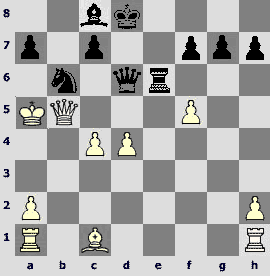
29...¤xc4+. What a pity! Cheparinov finds a relatively simple forcing way exactly at the moment, when he has an opportunity to finish the game with a series of sacrifices – 29...¦e3! 30.c5 (30.Ґxe3 Јa3+) 30...Јxd4 31.Ґxe3 Јc3+ 32.Јb4 ¤c4+ 33.ўb5 a6+ 34.ўc6 ¤e5+! 35.ўd5 Ґb7+! 36.Јxb7 Јc4+! 37.ўxe5 f6#
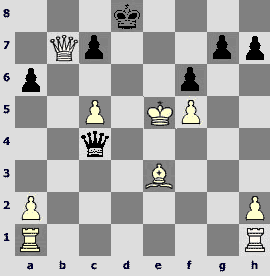
It would be grandly! In the encounter the white king also turned out to be mated, but somehow prosily. Obviously, being in a time trouble, White did not pay attention to the opponent's moves.
30.Јxc4 Јb6+ 31.ўa4 Ґd7+ 32.ўa3 Јa5+ 33.ўb2 ¦b6+ 34.Јb3 (34.ўc2 Ґa4+ 35.ўd3 Ґb5) 34...Ґa4 35.f6 Ґxb3 36.axb3 Јd5 37.fxg7 Јxb3#.
The beautiful heroic myth about Ulysses tells us that he returned to the same place, he had come out, and killed all the rascals, who profaned. And the life is really biter! Odd and pitiful pilgrim plods on the way e1-f1-e1-d2-d3-c4-c5-b5-a6-a5-a4-a3-b2, receiving kicks and blows, and finally does not return home.
Further we have a set of overseas curiosities. The conditions of the greatest Open in Minneapolis were quite not appropriate for the creativity: there were 2 rounds a day, so the players were chained down. However, the high financial price inspired them. In the struggle for the considerably large sum of money people were totally giving all they have got. And it is well-known that when all the recourses are already tried, only the beauty remains. Anyway, Solzhenitsyn interpreted Dostoevsky in such way in his Nobel speech.
KACHEISHVILI – SMIRIN
Minneapolis HB Global Chess Challenge
1.d4 ¤f6 2.c4 g6 3.¤c3 Ґg7 4.e4 d6 5.¤f3 0-0 6.h3 ¤a6 7.Ґg5 Јe8 8.Ґe2 (Smirin had occasion also to fight against 8.g4)
8...e5 9.d5 ¤h5 10.g3 f5 11.exf5 gxf5 12.¤h4 ¤f6. Black has received an advantage in the center, White has to recollect the precept of Nimzovich: "Break!" Many representatives of Generation P think that he had to do just the opposite, but basically chess is an old-fashioned game, hence, it has difficulties with marketing, distribution, promotion etc. However, there are other sections on the site to discuss these matters, so I will not interfere in these affairs.
13.Јc2. In the game Almeida – Hillarp Persson, Sants 2003, after 13.g4 Black purposefully exchanged his knights – 13...¤e4! 14.¤xe4 fxe4 15.Јc2 ¤c5 16.Ґe3 Јe7 17.¤g2 ¤d3+! 18.Ґxd3 exd3 19.Јxd3 Ґd7 and obtained good compensation for a pawn as the knight is very far from the key square: the way from g2 to e4 is too long.
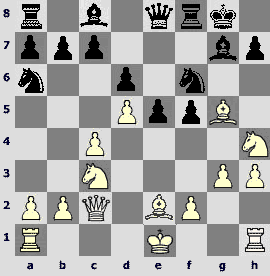
Kacheishvili knew this position. In Athens 2003 Vouldis opted for 13...h6 in the game against him. Further a subtle struggle for a tempo began: 14.Ґd2 (if 14.Ґe3, then 14...f4! 15.gxf4 exf4 16.Ґxf4 ¤b4 17.Јb1 ¤fxd5! 18.¤xd5 ¤xd5, and he regains the pawn) 14...¤c5 (here in reply to 14...f4 15.gxf4 exf4 White can simply answer 16.0-0-0) 15.Ґe3 (of course, not 15.¤xf5? Ґxf5 16.Јxf5 ¤fe4) 15...e4 (and again in case of 15...f4 16.gxf4 exf4 White ignores the f4-pawn – 17.Ґxc5 dxc5 18.0-0-0 with an advantage) 16.0-0-0 Ґd7 17.ўb1 a6 18.Јd2. The situation became stable and advantageous for White: it is convenient to locate his minor pieces on the squares d4 and f4. Smirin chooses another continuation; however, even in this case the play does not find its proper course straight away.
13...¤b4 14.Јb3 a5 15.a3 ¤a6 16.Јc2 ¤c5. Taking into account White's reply, it would probably had been better to wait with this move. 16...Bd7 comes into consideration.
17.Ґe3! I think, Ilya has understood at the moment that the prospect of an exchange Ґxc5 dxc5 followed by 0-0-0 and ¦he1 does not captivate him, and White has a good play along the central files. In case of 17...¤fe4 18.¤xe4 ¤xe4 a blowing up 19.g4! is unpleasant. The move chosen by Black also has some disadvantages.
17...b6 18.0-0-0 a4 19.ўb1 ¦b8 20.¤b5 (the weakening of the white squares on the queenside is quite sensible) 20...¦b7. In reply to 20...Јd7 he could also play 21.¤a7!?
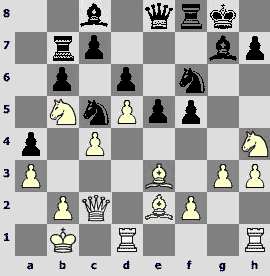
21.g4! A very good move. Very tempting is 21.Ґxc5 bxc5 22.¤xf5 Ґxf5 23.Јxf5 ¤xd5 24.Јe4, but here Black holds by 24...c6, for example, 25.ўa1?! (25.¤xd6?? is rather early in view of 25...¤c3+; in case of exchange sacrifice 25.¦xd5!? cxd5 26.Јxd5+ Јf7 27.¤xd6 Јxd5 28.cxd5 ¦b6 29.¤c4 ¦g6 30.¦f1 e4 black pieces are very active, though the strong d-passer ensures White a counterplay) 25...Јb8 26.Ґd3 ¤f6 27.Јxc6 e4! 28.Ґxe4 ¦b6, and White loses a piece.
21...f4 (There's no need to calculate the variations after 21...fxg4?! 22.hxg4 It's clear that the open h-file will cause the black king a lot of disturbance) 22.Ґxc5 bxc5 23.g5.
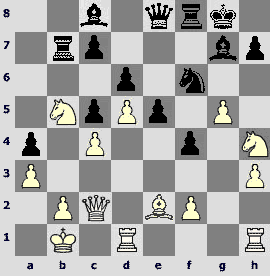
23...e4!? A move made with a heavy heart (in case of 23...¤d7 24.Ґd3 Јh5 25.¤f5 White has a too pleasant play), but anyway it is a pleasure to see it.
24.¦de1? As Evgeny Naier rightly noticed in the "Chess weekly" magazine, after the primitive 24.gxf6 Ґxf6 25.Ґg4!? Ґxh4 26.Ґxc8 Јxc8 27.¦hg1+ ўh8 28.¦g4 Ґf6 29.Јxe4 (or 25.¦dg1+ ўh8 26.¦g4!? Јe7 27.¦xf4 Ґxh4 28.¦xf8+ Јxf8 29.Ґg4) White settles a noticeable positional advantage. One can't "eat" the horse as my friend Ilya Odessky likes – with knife and fork, napkin, menu and attentive waitress...
24...¤xd5! (this Herod kicks!)
25.cxd5 Ґd7! It is better than 25...f3 26.¤xf3 (26.Ґc4?! ¦f4) 26...exf3 27.Ґd3 Јd7 28.¤c3 with an unclear position.
26.¤c3 Јe5 (it is practically a fork for 2 knights!) 27.ўa2 Јxg5. 27...¦fb8 28.¦b1 Јxg5 29.Ґg4 is also possible, but Smirin sagaciously allows his opponent making an error.
28.Ґg4!
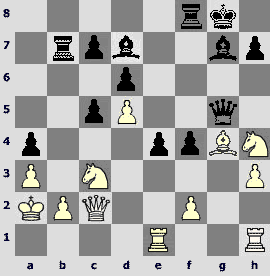
28...¦fb8! 29.Ґxd7? He had to make a humble move 29.¦b1. In that case the following variation would lead to a draw 29...Ґb5!? 30.Јxe4 (it is impossible to play 30.¤xb5? Јxd5+ 31.ўa1 ¦xb5 with a catastrophe on the b2-square; but interesting is 30.Ґe6+ ўh8 31.¤f5!? Ґd3 32.Јd2 Ґxb1+ 33.¦xb1 with mutual chances) 30...Јxh4 31.Ґc8! (an elegant throw in) 31...Ґxc3 32.bxc3 Ґc4+ 33.ўa1 ¦xb1+ 34.¦xb1 ¦xb1+ 35.ўxb1 Ґb3 36.Јe8+, and perpetual check is inevitable.
29...Ґxg4 30.hxg4 Ґxc3 is more promising, but even here after 31.Јxc3 (bad is 31.bxc3? ¦xb1 32.¦xb1 ¦xb1 33.Јxb1 Јxh4 34.Јb8+ ўf7 35.Јxc7+ Јe7, and queen's endgame is won for Black) 31...¦b3 32.Јc4 Јe5 33.Јc2 Јxd5 34.ўa1 Black hardly has something more than a move repetition – 34...Јd4 35.ўa2 Јd5. He could try to exchange queens and obtain a phalanx in the centre, but the pawns are located far apart – White will likely create a counterplay on the kingside.
29...¦xb2+ 30.Јxb2 ¦xb2+ 31.ўxb2 Јxd5. Having at the moment two rooks and two knights for the queen (plus 4 pawns!) White is helpless against the threats of Јb3+ and Јd2+.
32.ўc1 Ґxc3 33.¦hg1+ ўf8 34.¦e2 Јb3. White resigned.
The next game was also played in the last round of the competition in Minneapolis and is another example of the fact that in this life one can always perform a feat.
HARIKRISHNA – STRIPUNSKY
Minneapolis HB Global Chess Challenge
1.c4 e5 2.¤c3 Ґb4 3.Јb3 ¤c6 4.e3 ¤f6 5.¤ge2 0-0 6.a3. There are many untrodden tropes in this nameless opening. The arisen position has rarely occurred in practice. More popular is 4.¤f3 or 5.a3 Ґxc3 6.Јxc3, and instead of the text-move one usually tried to fianchetto the bishop – 6.g3. In the encounter Anastasian-Razuvaev (Moscow 1989) Black obtained an excellent play on the light squares with incredible ease: 6...e4! 7.Ґg2 ¦e8 8.0-0 Ґxc3!? 9.¤xc3 d6 10.a3 Ґf5 11.Јc2 (perhaps, he should have taken the b7-pawn) 11...Јd7 12.b3 ¤e5 13.Ґb2 ¤f3+ 14.ўh1 ¤g4! 15.Ґxf3 exf3 16.Јd1 ¤e5.
6...Ґc5 7.¤g3 d6. Black is not afraid of exchanging his dark-squared bishop for a knight after 8.¤a4, because in this case he will obtain a firm control over the centre and it is going to be hard for White to activate his bishops. Harikrishna has found the disposition, when all the pieces are of maximal use. Oh, how much I would like to develop the subject of Hindu treatment of the elephants: how they were domesticated from the earliest times, how they dragged logs, defended against the enemies, provided people with cool shower in the hot weather, and on the chess-board they brought a lot of glorious triumphs to Sultan Khan and Anand... but I hold in, I hold in...
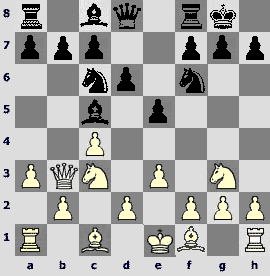
8.Ґd3!? a5 9.Јc2 ¤e7. Stripunsky is about to move the central pawns, however, very quickly it becomes clear that there some obstacles in realization of this intention. Another plan deserves attention –9...ўh8!? with an idea to prepare f7-f5, for example, 10.b3 ¤g4 (he can not fear for the h7-pawn) 11.Ґb2 f5, and White cannot deliver a blow on f5 in view of the vulnerability of the f-pawn, or 11.Ґf5 Ґxf5 12.Јxf5 ¤h6 followed by f5-f4. In case of 10.h3 ¤e8 it is possible to make a good use of the queen's location on h4.
10.b3 c6 11.Ґb2 Ґb6. In case of 11...d5 12.cxd5 cxd5 (12...¤exd5? 13.¤xd5 Јxd5 14.¤e4 leads to the loss of the h7-pawn) 13.¤b5 White exchanges the knight for a bishop under different circumstances – 13...Ґd6 14.¤xd6 Јxd6 15.¦c1, and the proboscideans surpass the ungulate animals in an honest open position.
12.¦c1 Ґe6. And again premature is 12...d5 because of 13.cxd5 cxd5 14.¤a4.
13.0-0 h6. Black postpones the advancement d6-d5 with the same constancy as FIDE did with the Kasparov's matches. There is nothing surprising in the fact that the pawn remained on d6 till the end of the game. However, here Alex had a valid reason. After 13...d5 14.cxd5 cxd5 15.¤a4 he can keep the dark-squared bishop from being exchanged by means of 15...¦c8 16.Јb1 Ґc7, but then White whisks away his workmate from the board – 17.¤c5 with an advantage. 13...¤g6 is preferable to the text-move, preventing f2-f4. Perhaps, it was unpleasant for Black to reshuffle his minor pieces after 14.ўh1 in view of the fork's threat f4-f5, but in case of 14...¦c8 the move 15.f4 is doubtful – 15...exf4 16.exf4 ¤g4, and the White's kingside is in danger.
14.f4 exf4.
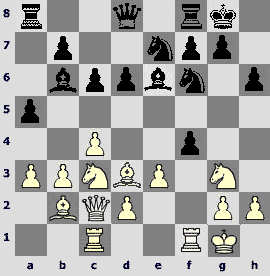
15.¤a4!? A grandiose move in style of Ivanchuk. It often happens that the right hand of Vassily does not seem to know what the left hand is doing, he can alternately make various moves on different flanks, which do not seem to be related to one unified idea. However, his opponent perplexedly finds out that the position of Ivanchuk steadily gets better (those who read the survey till the end, will have an opportunity to make sure of it). The young Indian shows that he is also able to scrutinize the board with a defocused look. Not bad is a simple 15.¦xf4 ¤g4 16.¦cf1 ¤e5 17.Ґh7+ ўh8 18.Ґf5, but the move in text forces the opponent to doubt the basis of being and, at the same time, takes extra minutes on the clock.
15...Ґa7. I think, Stripunsky has calculated both captures, and only having made sure that they do not promise any pleasure, he said "pass". After 15...fxg3 16.¦xf6! (threatening Ґh7+ and ¦xh6) 16...gxf6 unsuccessful is 17.Ґh7+? ўg7 18.Ґxf6+ ўxf6 19.Јc3+ ўg5 20.h4+ ўh5, and the king suddenly feels itself quite good. If the opponent attacks the f6-square: 18.¦f1, then Black can defend the b6-bishop by the move 18...¤c8! being totally ready to give the queen for a rook and a bishop. It is easy to decide on such exchange operation, when you have an extra pawn.
The correct move is 17.Ґxf6! The knight is pinned, and 17...¦e8 serves as the only defense from Ґh7#, but then 18.Ґh7+ ўf8 19.Јb2! So, we mark it out... copy... paste... "serves as the only defense"... and nothing serves anymore! I wish I could move the rook one square sideways. So, Black has to give up a queen without a sufficient compensation.
As a reply to 15...fxe3 I propose 16.¤xb6 Јxb6 17.dxe3 Јxe3+ 18.ўh1 followed by ¦f3, ¦c1-e1, ¤h5, and the black king should shiver with the hostile glares of the white pieces.
16.¦xf4. It is curious that 16.Ґxf6 fxg3 is weaker – a bishop on f6 is less useful, than a rook.
16...¤d7 (a different move order could be much more comprehensible – 15.¦xf4 ¤d7 16.¤a4 Ґa7 !)
17.¤h5 ¤e5 18.¦cf1 f6. The variations 18...¤xd3 19.Јxd3 f6 20.¤xg7! ўxg7 21.¦xf6 ¦xf6 22.¦xf6ќ or 18...¤7g6 19.Ґxg6 ¤xg6 20.Ґxg7! ¤xf4 21.¦xf4ќ prove that Black is right in his attempts to strengthen the main diagonal. However, a drawback of the text move consists in the fact that the f6-square is accessible to too many white pieces. 18...f5 19.¦4f2 (with idea of ¤f4) could provide a better defense – White has an advantage, but the play promises to be long.
19.¤c3 Јe8? There was no alternative to 19...f5. If you think that one can prevent the move of the knight on e4 by d6-d5, then Fritz and I will try to dissuade you (Fritz has to be pushed to sacrifice sometimes, but he is a quick-witted piece of code):
a) 19...¤xd3 20.Јxd3 d5 21.¤xf6+! gxf6 22.¦xf6 ¦xf6 23.¦xf6 Јd7 (23...dxc4 24.Јe4! Ґf7 25.Јg4+ ўf8 26.¤e4 with a strong attack) 24.¦xh6 Ґf5 25.¤e4!, and both in case of 25...dxe4 26.¦h8+ ўf7 27.Јxd7 Ґxd7 28.¦xa8, and in case of 25...Ґxe4 26.¦h8+ ўf7 27.Јf1+ Јf5 (27...¤f5 28.¦xa8 Ґb6 29.g4) 28.Јxf5+ Ґxf5 29.¦xa8 White has a won endgame;
b) 19...d5 20.¤xd5! ¤xd5 (20...¤xd3 21.¤xe7+ Јxe7 22.Јxd3) 21.cxd5 Јxd5 22.Ґc4! Јd7 (22...¤xc4 23.¤xf6+! ¦xf6 24.bxc4; 22...Јd6 23.Ґxe5 Јxe5 24.Јg6) 23.¦xf6! Ґxc4 (23...gxf6 24.Ґxe5ќ) 24.¦xf8+ ¦xf8 25.¦xf8+ ўxf8 26.Ґxe5.
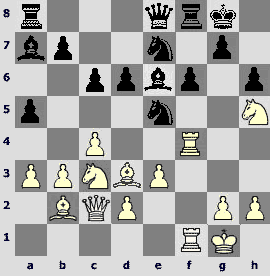
20.¤xf6+! gxf6 21.¤e4. It turns out that the elephants d6 and f6, on which the turtle e5 stands, have weak knees, and the interestingly conceived construction does not hold. By the way, Copernicus... however, all right, let us not digress.
21...Ґf5 (21...f5 22.¤xd6)
22.¦xf5 ¤xf5 23.¦xf5 Јe6 24.¤g3! ¦ae8 25.¦f4 ¤g4. Perhaps 25...¤xd3 26.Јxd3 Ґxe3+ 27.dxe3 Јxe3+ 28.Јxe3 ¦xe3 could give more practical chances, but White does not have to force the game into the technical track. After 29.¦g4+ further losses are inevitable for Black: 29...ўf7 30.¤f5 ¦xb3 31.¦g7+ ўe8 (31...ўe6 32.¤d4+) 32.¤xd6+ ўd8 33.Ґd4 with a foolish idea Ґa7-b8-c7#! or 29...ўh7 30.¤h5 ¦e1+ 31.ўf2 ¦b1 32.Ґxf6 ¦f7 33.ўe2 ¦xb3 34.Ґg7! followed by ¤f6+, and White remains with an extra piece.
26.¤f5 h5 27.Јd1 ¦f7 (defending against ¦xg4+)
28.h3 ¤xe3 (28...¤e5 29.Ґc2)
29.dxe3 Ґxe3+ 30.¤xe3 Јxe3+ 31.¦f2 ¦fe7 (31...Јe1+ is also hopeless: 32.Јxe1 ¦xe1+ 33.ўh2)
32.Ґf1 ¦e4 33.Јxd6. Black resigned.
The next encounter did not produce a huge impression on the experts, but the analysis shows that it has quite a rich content. Moreover, I think that chess fans will be happy to look through the contemporary play of Gata Kamsky.
KAMSKY – PRUESS
Minneapolis HB Global Chess Challenge
1.e4 e6 2.d4 d5 3.¤c3 ¤f6 4.e5 ¤fd7 5.f4 c5 6.¤f3 ¤c6 7.Ґe3 a6 8.Јd2 b5 9.Ґd3 b4 10.¤d1 Јb6.
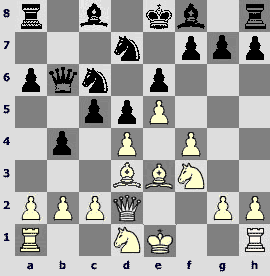
11.0-0!? A new move in this position – 11.Јf2 was employed previously. The very idea of using the black d4-pawn as the cover for White's operations on the kingside was described and practically tested by Nimzovich (of course, if he did not spy it from his predecessors).
11...¤xd4 The decision to exchange a pair of knights is correct.
12.¤xd4 cxd4 13.Ґf2 a5. In reply to a natural 13...Ґe7 White could answer 14.¦e1 or 14.Јe1 with a sample line 14...¤c5 15.Ґh4 ¤xd3 16.cxd3 Ґxh4 17.Јxh4 0-0 18.¦f3, with promising kingside initiative. Surely if this idea of Gata is adopted in practice, Black will take care of a more subtle move order.
14.Ґh4! White establishes an interaction of pieces, causing Black some inconvenience at the same time.
14...g6. I dare to advise 14...¤c5 15.¤f2 ¦a7 followed by Ґe7 and 0-0. It does not mean that I blame the text. Of course, the holes he makes are obvious, but it is also clear that the opponent will have to show a drastic play, probably even with sacrifices, to make use of these weaknesses. And sacrifices require creativity.
15.¤f2 Ґg7. In case of 15...h5 the knight finds another good route – 16.¤h3.
16.¤g4
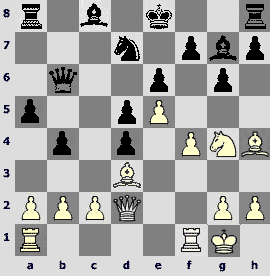
16...Ґa6. From now on Black has to consider on each move whether the king is ready for castling. Now the choice is correct: 16...0-0 allows a strong attack along the dark squares after 17.Ґf6 (with an idea of Јf2-h4) 17...Ґxf6 (by the way we can take pleasure in the variation 17...¤xf6? 18.exf6 Ґh8 19.¤h6#) 18.exf6.
Let us branch out – 18...ўh8 19.Јf2±, or 18...Јd8 19.f5! e5 (19...exf5 20.¦xf5! loses straight away) 20.fxg6 fxg6 21.Јg5 with a decisive attack after Ґxg6!, or18...h5 19.f5! exf5 (19...hxg4 20.Јh6 ¤xf6 21.fxg6 with mate) 20.Ґxf5! d3+ (20...¤xf6 21.¤xf6+ Јxf6 22.Ґxc8 – the worse version of the main file, and after 20...hxg4 21.Ґxd7 Black somehow defends from the awful threat of Јh6 – 21...ўh7 22.Јg5 d3+ 23.ўh1 ¦h8, however, 24.Јxd5 with a double blow on а8 and f7 finishes pressing out) 21.ўh1 ¤xf6 22.¤xf6+ Јxf6 23.Ґxc8 Јxb2 24.Ґb7, and Black has no enough compensation for the piece.
17.¦ae1 Ґxd3. At the moment he should have understood that the opposition of the black king and the white rook is not to be underrated. In case of 17...¦c8 18.f5! gxf5 (or 18...exf5 19.¤f6+ Ґxf6 20.exf6+ ўd8 21.Јe2 and further Јe7-f7 with a clear advantage to White) 19.Јg5 Ґf8 Black's position quickly collapses – 20.¦xf5! exf5 (20...h6 21.Јh5 ¦h7 22.¦xf7 ¦xf7 23.¦f1ќ) 21.e6 fxg4 (21...fxe6 22.Јh5#) 22.Јf5.
18.cxd3 h5. Again we consider 18...0-0. After a known 19.Ґf6 Ґxf6 20.exf6 Јd8 21.f5! ¤xf6 22.¤xf6+ Јxf6 23.fxe6 Јg7 24.e7 ¦fe8 25.Јc2 Black can hardly succeed defending the pawns on the left side of the board, because the e7-passer requires too much attention.
19.¤f2 ¦c8. As it becomes clear from the further actions, Black has gambled on the c-file. In its exploitation he obtains a lot, nevertheless, the initiative of White outweighs. Perhaps, it could make more sense if he had opened more files on the queenside. Stronger is 19...b3. After 20.axb3 it is important not to give the opponent the control over the cherished highway: in case of 20...Јxb3 21.¦c1 0-0 22.¦c7 ¤b6 23.f5! exf5 (if 23...Ґxe5 24.fxg6! Ґxc7 25.Јh6 fxg6 26.Јxg6+ ўh8 27.Ґf6+ ¦xf6 28.Јxf6+ ўg8 White in one move 29.¤h3 brings knight and rook into the attack and wins) 24.e6! fxe6 25.Јg5 it is not going to be easy to defend from various threats. However, the continuation 20...¤c5! 21.Јe2 ¤xb3 still keeps White in a certain ignorance of the attack direction. For example, the king can settle on d7, then one will have to arrange everything once again.
20.ўh1 ¦c6 21.Јd1! 0-0.
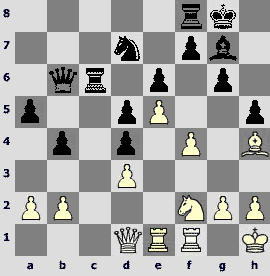
A castling is akin to a shot of the starting gun. The tribunes hoot, and the bonnets are thrown up in the air.
22.g4 hxg4 23.¤xg4 ¦fc8 24.Јf3 ¦c2 25.Јh3 ¦xb2. Black follows his principles. Bringing the queen back to a defense could probably offer a tougher resistance but in the end White has enough resources for an attack, so he should prevail – 25...Јc5 26.Ґf6 Јf8 27.f5 exf5 28.Ґxg7 ўxg7 (if 28...Јxg7, then 29.¤h6+ ўf8 30.¤xf5! gxf5 31.¦g1 winning exactly the queen, which has returned to a defense) 29.¤h6! Now both alternative queen moves lose: 29...Јh8? 30.¤xf5+ gxf5 (30...ўg8 31.¤h6+) 31.¦g1+ and 29...Јe8 30.¤xf5+! (but no 30.¦xf5? ¦c1!) 30...gxf5 31.¦g1+ ўf8 32.Јh6+ ўe7 33.e6ќ. The most stubborn is29...¤xe5!? 30.¦xe5 ¦c1. Here the sacrifice on f5 does not work, however, after 31.¦ee1! ¦xe1 32.¦xe1 White returns the extra piece as 32...Јh8 loses again to 33.¤xf5+! gxf5 34.Јg3+ ўf8 (34...ўh7 35.Јh4+! ўg8 36.¦g1+) 35.Јd6+ ўg8 36.¦g1+ ўh7 37.Јd7.
26.Ґf6! ¦cc2. Maurice Ashley annotating the game on the official site gives a nice variation 26...Ґxf6 27.exf6 ¤xf6!? (27...Јd8 28.f5) 28.¤xf6+ ўg7 (threatening ¦h8)
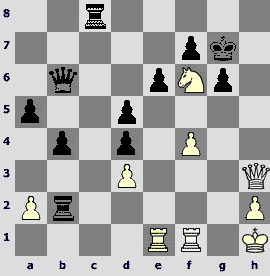
29.Јh7+! ўxf6 30.f5 exf5 31.¦xf5+! ўxf5 (31...gxf5 32.Јh6#) 32.Јxf7+ ўg5 33.h4+! ўh5 (or 33...ўxh4 34.Јf4+ ўh3 35.¦g1! with an elementary problem of the cooperative mate in one move –35...¦h2+!? 36.Јxh2#) 34.Јf3+! ўh6 35.Јf4+ ўh7 36.¦e7+, and the suffering of the mated black king forces us to recall the encounter that has opened our survey.
I would like to add that 26...¤xf6 27.exf6 Ґh8 (27...Ґf8 28.¤h6+) may be followed by 28.f5 exf5 29.¤h6+ ўf8 30.¤xf5 Ґxf6 (30...Јxf6 31.¤d6) 31.¤e7! ¦cc2 (31...Ґxe7 32.Јh8#) 32.Јh6+ Ґg7 33.¤xg6+ Јxg6 34.Јxg6 ¦xh2+ 35.ўg1, and the queen keeps keep vigilant watch on the board, so that no one could dare to offend her king.
27.f5! Comrades! The breakthrough that the Bolsheviks were so long talking about...
27...exf5. After 27...gxf5 28.Ґxg7 ўxg7 29.Јh6+ ўg8 30.¦g1 it becomes clear why Gata has played 20.ўh1! Maybe, he has foreseen everything? Yes, of course! Yet when he played 11.0-0...
28.Ґxg7 ўxg7 29.Јh6+ ўg8
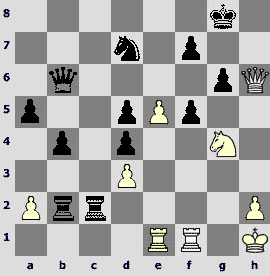
30.e6! fxe6. Stop the moment! Black has 4 extra pawns.
31.Јxg6+. It does not stop. Black resigns though he could check what move will follow 31...ўf8. Right is 32.¦xe6, and a spectacular 32.¦xf5+? ўe7! is a so-so idea.
Further on we see a splendid game of one ex-inhabitant of Saint Petersburg. By the way, his opponent has also weakened the dark squares on the kingside without absolute necessity.
YUDASIN – BENJAMIN
Minneapolis HB Global Chess Challenge
1.e4 c6 2.d4 d5 3.exd5 cxd5 4.Ґd3 ¤c6 5.c3. Let us slip by the opening part at least in deference to Leonid. He has already clearly shown that he transfers all the heaviness on the middlegame.
5...¤f6 6.Ґf4 Ґg4 7.Јb3 Јd7 8.¤d2 e6 9.¤gf3 Ґxf3 10.¤xf3 Ґd6 11.Ґxd6 Јxd6 12.0-0 (it is known that in case of the capture on b7 Black has a compensation) 12...0-0 13.¦ae1 ¤d7 (the plan with 13...¦ab8, preparing b7-b5, is considered to be reliable) 14.Јc2.
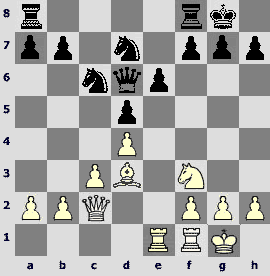
14...g6. On the one hand, it is correct to say "quiet!" to the opponent's bishop. On the other, now Black should return his own dark-squared warrior on board to be happy. Rustem Dautov has won the game having used 14...h6, but there the forces of the opponents were obviously unequal. On the whole, there are no reasons to panic yet.
15.¦e3! Јf4 (this move is not the most obligatory)
16.¦fe1 ¦ab8 17.Јe2 ¦fc8. Black obviously yields to his opponent in purposefulness, but the opening scheme is so inoffensive that the equality is not seriously destroyed yet.
18.h3! If White plays ¤h2, ¦f3, ¤g4, then he will be aggressively located.
18...¦c7. One more anemic move. 18...a6 is more natural, if you create a counterplay on the queenside, and in reply to 19.¤h2 it is possible to answer 19...¤f6! After 20.¦f3 Black has a unique, but sufficient move 20...Јg5. He does not lose his knight, but prevents the white one from activating.
19.¤h2 ¤e7 (and here not bad is 19...¤f6)
20.¤g4. Obviously both opponents can understand that 20.¦xe6 fxe6 21.Јxe6+ ўh8 22.Јxe7 ¤c5! 23.Јe2 ¤xd3 24.Јxd3 b5 brings no real result for White. However, now White's concentration looks really menacing.

20...ўg7? Correct is 20...¤f5! 21.Ґxf5 gxf5. One has to open the line, in which there are no opponent's heavy pieces. In case of 21...exf5? Black loses: 22.g3 Јg5 23.¦e8+ ¦xe8 24.Јxe8+ ўg7 (24...¤f8 25.f4) 25.¦e7 or22...Јd6 23.¤h6+ ўg7 24.¤xf7! ўxf7 25.¦e6 Јf8 26.¦e7+ ўg8 27.Јe6+ ўh8 28.¦xd7.
After 21...gxf5 22.¦f3 Јg5 (courageous against his will; bad is 22...Јd6? 23.¤h6+ ўg7 24.¦g3+! ўxh6 25.Јd2+ f4 26.¦e5!, and Black has to give up a queen he wanted to preserve from troubles so much) 23.¦g3 ўh8! 24.¤e5 Јf6 25.Јh5 ¤f8! followed by ¤g6 and Black holds, though it may seem strange.
21.¦f3 Јg5. In the event of 21...Јd6 22.Јe3 white queen penetrates to h6, however, even after the text White has more than one possibility to obtain a clear advantage.
22.Ґb5. This thrust became a beginning of the combination, which he could carry out straight away: 22.¦xf7+!? ўxf7 23.Јxe6+ ўf8 24.¦e3 gives White a strong attack. Another possibility is – 22.h4! Јxh4 (22...Јxg4? 23.¦xf7+) 23.¤e5! Black barely manages to defend form direct threats, for example, 23...¦f8 (in case of 23...¤f6 24.¤xf7! ўxf7 25.Јxe6+ ўg7 White bereaves the black queen of the g5-square and wins: 26.Јe5! ¦bc8 27.g3ќ) 24.¤xf7!? (simple 24.¤xd7 ¦xd7 25.Јe5+ f6 26.Јxe6 ¦fd8± also woks) 24...¦xf7 (24...¤c6 25.¤d6) 25.¦xf7+ ўxf7 26.Јxe6+ ўe8 (26...ўf8? 27.Јd6 loses a piece) 27.Јg8+ ¤f8 28.Ґb5+ ¦c6 29.Јxd5 Јf6 30.Ґxc6+ bxc6 31.Јa5. White has good winning chances, although he should always be on the alert with this queen and these knights.
22...¤c6.
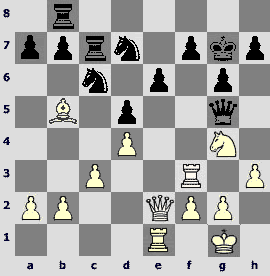
23.¦xf7+. This sacrifice does not lead to a forced win, but it was exactly the reason why it impressed the experts. The maneuvers of Yudasin create an impression because he made them without a rook and they turned the scale in the needed direction.
23...ўxf7 24.Јxe6+ ўg7 25.Јd6 Јd8? Simple 25...¦bc8 allows Black to fight off after 26.Ґxc6 bxc6 27.¦e7+ ўh8 28.¦xd7 (or 28.f4 Јf5 29.¤h6 Јf6, forcing a simplification) 28...¦xd7 29.Јxd7 Јc1+ 30.ўh2 Јf4+ 31.g3 Јc7. It seems that there was a betrayal – just have a look, the black king is lonely located on one side while all the warriors are on another.
26.Ґxc6 ¦xc6. In case of 26...bxc6? 27.¦e7+ ўh8 any knight move wins e.g. 28.¤f6 ¤f8 29.Јxd8 ¦xd8 30.¦xc7.
27.Јe7+ ўh8?! In principle, optimism is a good quality. And at this moment Benjamin can still refuse a cheerless ending with problematical chances for a draw – 27...Јxe7 28.¦xe7+ ўg8 29.¦xd7 ¦b6 30.b4 ¦c8 31.¤e3 ¦xc3 32.¤xd5 ¦c1+ 33.ўh2 ¦e6 34.¦xb7 a6. However, Black had to sense clearly the danger of the queen's threats .
28.Јf7.

28...¦c7? There is no rescue after this move. It is time to jettison the ballast – 28...¦f6! 29.¤xf6 ¤xf6 30.¦e7 Јf8 31.Јe6 ¦e8 32.¦xe8 ¤xe8 33.Јxd5, and Black does not run the risk of losing. For justice, we have to say that it is almost impracticable to foresee all the movements of white pieces and to evaluate correctly theirs' consequences. In my opinion, the 33rd move of Yudasin is particularly prominent.
29.¦e7 Јg8 30.Јf4! Јf8. Now it is impossible to manage with primitive methods – 30...¦bc8 31.¤e5! ¦f8 (31...Јf8 32.¤xg6+! hxg6 33.Јh4+ with a mate) 32.Јe3, and White wins a knight, or 30...Јd8 31.Јg5 threatening with both Јh4 and ¤e5.
31.¦f7 Јg8. In the variation 31...Јe8 32.¤e5 ўg8 33.Јh6! Јxf7 34.¤xf7 ўxf7?! 35.Јf4+ Black'shangingrooktells cruelly. There is a temptation to suggest that the rook was damned already at the 18th move.
32.¤h6 Јd8. The situation seems to be rather the same as after the 25th move.

33.Јe3! It is a pleasure to win the game by such a quietest move.
33...¦bc8. Insufficient is 33...¤f6 34.Јe5! ¦c6 35.¤g4. After 33...¦c6 a combinational squabble with numerous pieces expositions 34.¦xd7!? Јxd7 35.Јe5+ ¦f6! (35...Јg7? 36.Јxb8+) 36.Јxf6+ Јg7 37.Јe6! ¦f8 (37...Јxh6? 38.Јe5+) 38.¤g4 leads to a very pleasant position for White, but thematic 34.¦e7!ќ is stronger.
34.¦e7! White's pieces are fewer, but their scope is incomparably wider.
34...Јf8 35.¤f7+ ўg8 36.Јe6! Decisive approach. I would say, this move is very "dramaturgic". In the end of actions all the heroes meet in one place.
36...¦c6 37.¤d6+ ўh8 38.¦xd7. Black resigns.
It would be risky for the political point of view to present the competitive achievements from the tournament, which was played in Cuba, straight away after the games from an American open. Therefore, the next encounter is a small Azerbaijan interlude.
MAMEDYAROV – BAGIROV
Presidential cup
This game was mentioned in several lists, and I could not pass it over. However, since its crucial moment remained unclear to me, I give an extremely short report.
1.d4 d5 2.c4 e6 3.¤c3 Ґb4 4.¤f3 ¤f6 5.Ґg5 ¤bd7 6.e3 c5 7.cxd5 exd5 8.Ґd3 Јa5 9.0-0 c4 10.Ґf5 Ґxc3 11.bxc3 0-0 12.Јc2 ¦e8 13.¤d2 g6 14.Ґxd7 ¤xd7 15.f3. The Westphalian variation is a well-known opening. Its main tactical idea consists in eating the g5-bishop, if White plays e3-e4 without proper preparation, being keen on the realization of his general layout. Therefore, many insure against it and play 15.h4.
15...¤b6 16.¦fe1 Ґd7. Black carries out his main strategic plan, not taking paltry trouble about tempos. Thus, some moves before he could have waited a little with the exchange on c3, expecting the moment when White himself would induce it by means of a2-a3; now many would think about 16...¤a4 to force the rook (though even temporarily) to take a passive position on c1.
17.Ґh6 (perhaps, it is not the best location for a bishop, though it played his role excellently) 17...¦e6 18.e4 ¦ae8 (in case of 18...¤a4 it is already possible to play a planned 19.¦e3 and ¦ae1) 19.¦e3 f5 20.¦ae1 Јa4 21.Јb2 Јb5 22.Јc1 dxe4 23.fxe4 fxe4 24.¤xe4 Ґc6.
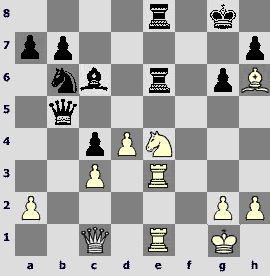
It seems that they both aimed at this position. And here Shakhriyar managed to surprise his opponent.
25.a4!? (if the knight retreats and 4 rooks are exchanged, the position is equal)
25...Јxa4? I failed to understand what could have happened after 25...¤xa4. The incident scene seems to be the following: one move ago Mamedyarov realized that he would win in case of 24...¤d5 25.¦f3. An immediate attempt to entice the knight on a "perfect central location" 25.d5 does not work, therefore the bait was put out for the queen. Bagirov calculated 25.a4 Јd5 26.¤f6+ ¦xf6 27.¦xe8+ Ґxe8 28.¦xe8+ ўf7 29.Јe3! ¦e6 30.¦f8+ ўe7 31.Јf4 with a decisive attack of White and refused to capture on a4 with a knight, having underestimated that all this variation had no real power without the d4-pawn: 25.a4 ¤xa4 26.d5 (in case of 26.Јa3 Ґxe4 27.¦f1 ¤c5 Black can also successfully defend) 26...Јxd5 27.¤f6+ ¦xf6 28.¦xe8+ Ґxe8 29.¦xe8+ ўf7 30.Јe1 (30.¦f8+ ўe7) 30...¦e6 31.¦f8+ ўe7 32.Јf1 ўd7, and the white king is weak. However, it can be only my fantasy, after all I even do not know, with the time control the game was played...
26.d5! After this push Black is lost.
26...¤xd5 (26...Ґxd5 27.¤f6+)
27.¦f3! (the rooks unnoticeably move on the other file behind the e4-knight's back)
27...Јa5 28.¦ef1 Јd8 (the switching on of 28...Јb6+ does not change the situation)
29.Јg5! ¦6e7 (or 29...Јc8 30.Јh4 threatening with ¤g5 and Јf2, and White wins).
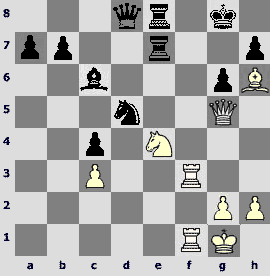
30.¤d6! Black resigns. 30.Јh4 could also win. After 30.¤d6 the encounter could have ended in the following way: 30...¤xc3 31.¦f6 ¤e4 32.¤xe8 Јd4+ 33.ўh1 ¤f2+!? 34.¦1xf2! Јxf2 35.¦xg6+ hxg6 36.Јxg6+ ўh8 37.Ґg7+ ўg8 38.¤f6+. Even if there are some signs of bluff, anyway it is great.
Many-many paragraphs before I said that it was important to begin correctly. Forget it. It is important to finish correctly so that the feeling of a holiday remains with a reader (spectator, listener). And thereto it is very useful to look through the play of Ivanchuk.
IVANCHUK – JOBAVA
Capablanca memorial
1.d4 ¤f6 2.Ґg5 ¤e4 3.Ґf4 d5 4.e3 c5 5.Ґd3 ¤c6. An aggressive continuation. However, to dispute it White also has to play defiantly. Sutovsky against McShane (Pamplona 2003) and Short against Aronian (Reykjavik, rapid 2004) preferred 5...¤f6. No matter how paradoxical it may seem, a humble retreat leads to fewer concessions than the normal developing move of Black. There is something strange in this scheme, because it turns out that in this position after 1.d4 d5 2.Ґf4 ¤f6 3.e3 c5 4.Ґd3 it is White's turn to move. On the other hand, where could you have seen 2.Ґf4 played by some respectable people? On the whole, I am not able to think about the advantages and disadvantages of an initial stage. Let us look through the following development of actions.

6.Ґxe4 dxe4 7.d5. As we see, Vassily also does not stuff his head with philosophy. He captures and moves along. In this position it is already silly to retreat the knight on the same square, where he has come from. There choice isn't too great. It is clear that the d5-pawn will prevent Black from a natural development, and theoretically, in such situations 7...e5 is the typical reaction. Polgar played in that way against Radjabov in Benidorm-2003. The further continuation was 8.Ґg3 ¤e7 9.¤c3 ¤g6 10.h4 h5 11.f3, and here Black could obtain an equal play by 11...exf3 12.¤xf3 Ґd6. Actually, 10.Јh5!? deserves attention, and probably 9.c4 as well. The move chosen by Baadur leads to an immediate conflict.
7...¤b4 8.¤c3 e6 (or White will play 9.a3 with an obvious advantage)
9.d6 (otherwise White has nothing at all, e.g. 9.dxe6 Јxd1+ 10.ўxd1 Ґxe6 11.a3 0-0-0+ 12.ўc1 ¤d5)
9...¤c6. The encounter Hodgson – Tseitlin, Ischia 1996, proceeded in an interesting way – 9...Јa5 10.¤ge2 Ґd7 (in case of 10...¤d5 11.0-0 ¤xf4 12.¤xf4 White has a huge lead in development) 11.0-0 f5 12.a3 ¤c6 13.b4! with White's initiative.
10.¤ge2. In the encounter against Wang Yaoyao (Pekin 1997) Speelman chose 10.¤xe4, and in the annotations he gave a nice line: 10...e5 (the Chinese played 10...f5 11.Ґg5 Јb6 12.¤f6+! ўf7! with huge complications) 11.Ґg5 Јb6 12.Јd5 Ґe6? 13.¤xc5! Ґxd5 14.d7#. After 10.¤ge2 English grandmaster advised 10...e5!? 11.¤b5 exf4 12.¤c7+ ўd7 13.¤xf4 Ґxd6 (bad is 13...¦b8? 14.Јg4+ ўxd6 15.Јg3! under the threat of attack) 14.¤xa8 ўe7 with good position of Black. It remained unknown, how Ivanchuk could have reacted, because Jobava deviated.
10...f5 11.¤b5 ўf7 12.¤c7 ¦b8. Once again we see a critical position, which is typical for this game. Black should come up with something tough to avoid material losses, and White has to consider what kind of advantage the location of the knight on c7 can bring. Having lost a pawn, he would not want to bolt out shamefully along the way c7-b5-c3.
I cannot remember, whether I read in Gik's works or in somebody else's that Arlamovsly having made a fatal move 5...¤gf6 in Caro-Kann, which allows a mate by the d6-knight, continued to sit at the board and to scrutinize attentively the position, so that Keres, who was always very polite, could not resist the temptation to mate from the opponent's rear. Of course, it is only a grotesque, but in the encounter in question there is something similar. I am sure that at the fleeting glance on the board after the 12th move most of the chessplayers, even well-qualified, would evaluate this position as difficult, knotty, double-edged etc. However, Ivanchuk makes a move, which wins straight away. Of course, it is not so obvious, but nevertheless the game did not last long.
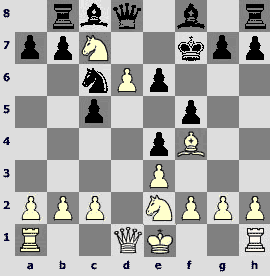
13.g4!! I think the boxing term "hook" is extremely appropriate here. It turns out that the black king cannot feel himself safe even behind the fence of pawns. The threat is very simple: after gxf5 he has some guests coming along the diagonal a2-g8. Strengthening the chain by g7-g6 causes only a smile, because the diagonal h5-e8 is by no means less convenient for a visit (13...g6 14.gxf5 gxf5 15.¤d4! h5 16.¤xc6 bxc6 17.¦g1 with a huge advantage of White). When you understand it, you also see that the number of possible defenses is very limited, because the "doomed" d6-pawn prevents black pieces to move. With the help of Fritz it is very easy for the annotator to grasp the situation (and Ivanchuk does not need any calculating facilities to do it) that 13...e5 is loosing in view of 14.Јd5+ ўf6 15.h4! with excellent mates after 15...h6 16.g5+ ўg6 17.h5+ ўh7 18.g6# or 15...exf4 16.g5+ ўg6 17.¤xf4#, and even if 13...g5, then 14.gxf5! gxf4 (14...exf5 15.Јd5+ ўf6 16.Ґg3 followed by h2-h4, and the number of pawns around the king becomes smaller) 15.fxe6+ Ґxe6 16.¤xf4 Ґc4 (16...Ґf5 17.Јd5+ ўf6 18.¤h5+ ўg6 19.¦g1+; 16...Јxd6 17.Јh5+ ўe7 18.¤fxe6) 17.Јh5+ ўf6 18.0-0-0 with a decisive attack.
13...fxg4 14.¤g3 ¤b4. He hopes to put the knight on d5, having paid off by a pawn, and move the pieces at liberty. Of course, White also did not observe the common rules of opening play, and nevertheless we should mention that during the 14 moves the black knight moved from c6 on b4 twice. The most principled was 14...g5, capturing the bishop, but this continuation was surely the first to be considered by Baadur and he understood that after 15.¤xe4 gxf4 16.Јxg4 his position looks bad, for example:
16...¦g8 17.Јh5+ ¦g6 (17...ўg7 18.¤g5) 18.¦g1 ўg7 19.¤g5 ¦xg5 20.¦xg5+ ўh8 21.0-0-0, and black king perishes under the blows of heavy pieces;
16...Ґxd6 17.Јh5+ ўe7 (provided 17...ўf8 18.¤xd6 only an abolition of both knight straight away could rescue Black, Јe8+ and ¦g1+ follow the capturing of only one of them) 18.0-0-0! Ґxc7 (in case of 18...Јxc7 19.Јg5+ Black loses too much material) 19.¦xd8, and none of 4 captures leaves chances for a salvation – 19...¤xd8 20.Јxc5+; 19...ўxd8 20.Јf7!; 19...¦xd8 20.Јxh7+and¦g1; 19...Ґxd8 20.Јg5+ ўf8 (20...ўf7 21.¤d6+ ўf8 22.Јh6+ ўe7 23.¤xc8+ and 24.Јg7+) 21.Јh6+ ўe8 22.Јg7! The person with really fine sense of the beauty of chess, would not resign, but carry the game through – 22...¦f8 23.¤d6#!
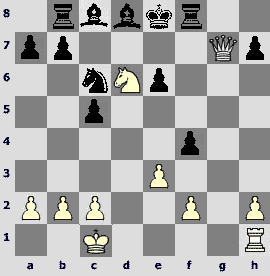
15.a3. Other ways are also good – 15.¤xe4 e5!? 16.Ґxe5 Ґf5 17.f3! gxf3 18.Јxf3 Јh4+ 19.¤g3 ¤xc2+ 20.ўd2 Јb4+ 21.Ґc3 or an exaggeratedly cool 15.0-0.
15...¤d5 16.¤xe4. He could move to meet requests of the seriously suffering opponent –16.¤xd5 exd5 17.Јxd5+ Ґe6 18.Јxc5 with an advantage that is enough to win. However, Ivanchuk prefers to see the black elephants to be hobbled.
16...¤xf4 17.exf4 ўg8. As a reply to 17...b5 winning is 18.Јxg4 Ґxd6 19.¤xe6! Ґxe6 20.¤g5+ ўe8 21.¤xe6 Јe7 22.0-0-0.
18.Јxg4
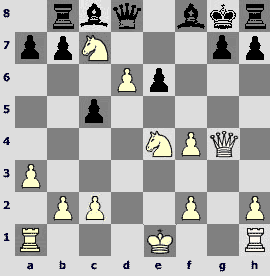
18...h5. In case of 18...Ґxd6 the toughest reply is an elegant 19.¤e8!
19.Јg3 b5 20.¦g1 ¦h6 21.0-0-0 ўh8 22.¤xc5 b4 23.axb4 ¦xb4 24.d7 ¦c4 25.¤5xe6.
THE END
